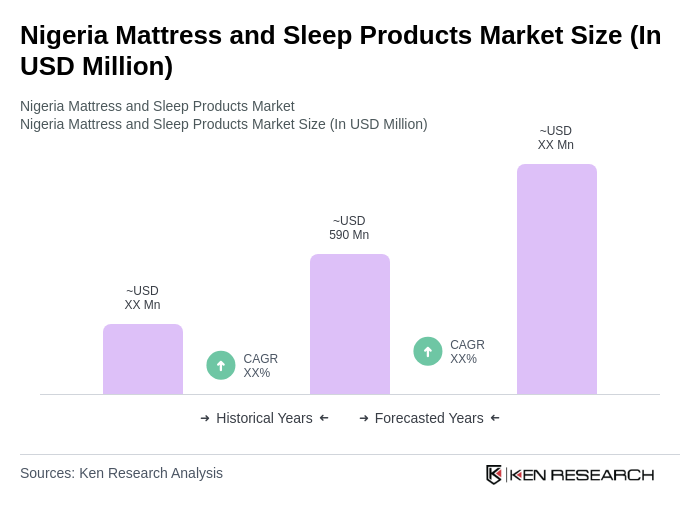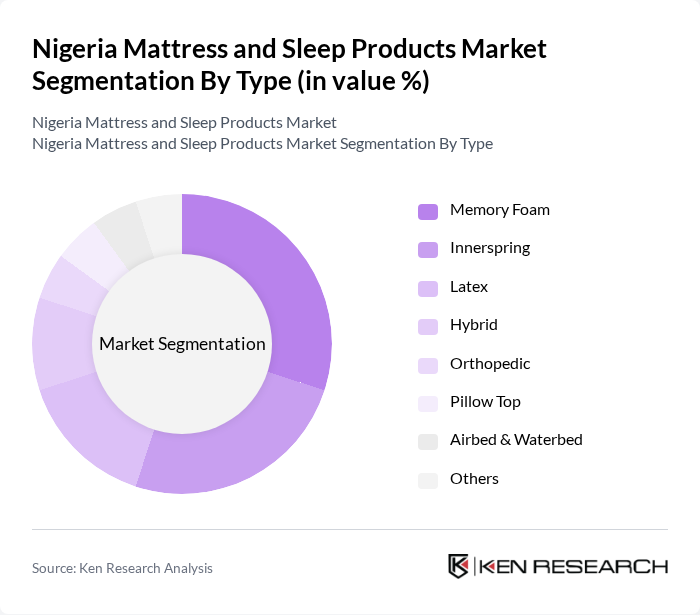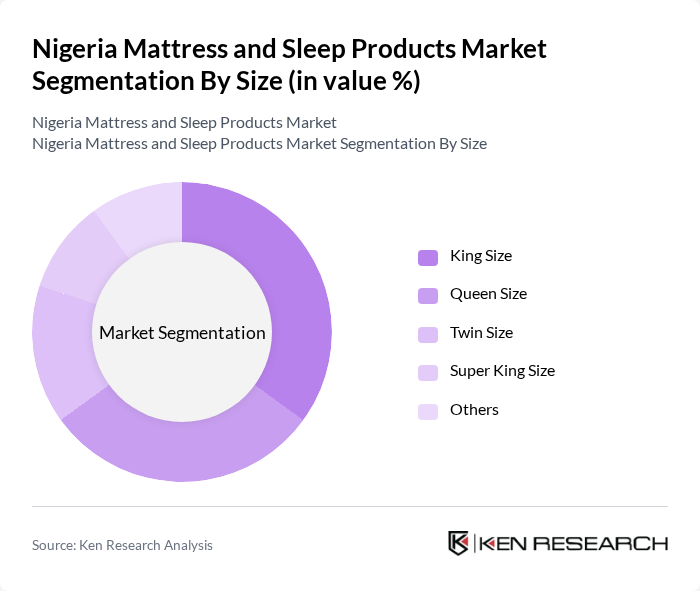Nigeria Mattress and Sleep Products Market Overview
- The Nigeria Mattress and Sleep Products Market is valued at approximatelyUSD 590 million, based on a five-year historical analysis. This growth is primarily driven by increasing urbanization, rising disposable incomes, and a growing awareness of the importance of sleep health among consumers. The demand for quality sleep products has surged, leading to a competitive landscape where manufacturers are innovating to meet consumer preferences. Recent trends also highlight the expansion of the middle class, a shift towards premium and orthopedic mattresses, and the entry of international brands offering customized solutions for Nigerian consumers .
- Lagos, Abuja, and Port Harcourt are the dominant cities in the Nigeria Mattress and Sleep Products Market. Lagos, being the commercial hub, has a high concentration of retail outlets and consumers with disposable income. Abuja, as the capital, has a growing middle class, while Port Harcourt benefits from the oil industry, contributing to increased demand for quality sleep products. These urban centers continue to drive market expansion due to ongoing housing development and migration trends .
- In 2023, the Nigerian government implemented theStandards for Mattresses and Allied Products (NIS 554:2023)issued by theStandards Organisation of Nigeria (SON). This regulation mandates that all mattress manufacturers obtain SONCAP certification, comply with health and safety standards, and undergo periodic product testing to ensure quality and consumer safety. The regulation covers labeling, material composition, and flammability requirements, thereby enhancing consumer trust and promoting a healthier sleep environment .

Nigeria Mattress and Sleep Products Market Segmentation
By Type:The market is segmented into various types of mattresses, including Memory Foam, Innerspring, Latex, Hybrid, Orthopedic, Pillow Top, Airbed & Waterbed, and Others. Among these,Memory Foammattresses are gaining popularity due to their comfort and support, catering to the growing consumer preference for personalized sleep solutions. Innerspring mattresses remain a traditional choice, while Hybrid options are appealing to those seeking a combination of support and comfort. The segment also reflects a rising demand for orthopedic mattresses as awareness of spinal health increases .

By Size:The market is also segmented by size, including King Size, Queen Size, Twin Size, Super King Size, and Others.King Sizemattresses are preferred by families and couples seeking more space, while Queen Size options are popular among individuals and smaller households. Twin Size mattresses are often used in children's rooms and guest accommodations, reflecting diverse consumer needs. The demand for larger mattress sizes is supported by the trend of modern housing and increased disposable income .
Nigeria Mattress and Sleep Products Market Competitive Landscape
The Nigeria Mattress and Sleep Products Market is characterized by a dynamic mix of regional and international players. Leading participants such as Mouka Limited, Vitafoam Nigeria Plc, Winco Foam Industries Ltd, Unifoam Nigeria Limited, Polly Foam Products Ltd, Royal Foam Products Nigeria Ltd, Sara Foam Nigeria Ltd, Tempur Sealy International, King Koil Nigeria, Sleepwell Nigeria, Duroflex Nigeria, Zinus, Sealy, Simmons, IKEA Nigeria contribute to innovation, geographic expansion, and service delivery in this space .
Nigeria Mattress and Sleep Products Market Industry Analysis
Growth Drivers
- Increasing Urbanization:Nigeria's urban population is projected to reach 220 million in future, up from 213 million. This rapid urbanization drives demand for quality sleep products as more people move to cities where living conditions often require better sleep solutions. Urban dwellers are increasingly investing in home furnishings, including mattresses, to enhance their living environments, thus propelling market growth significantly.
- Rising Disposable Incomes:The average disposable income in Nigeria is expected to rise to approximately $3,500 per capita in future, up from $3,200, as reported by the IMF. This increase allows consumers to allocate more funds towards home comfort products, including mattresses. As disposable incomes rise, consumers are more likely to prioritize quality sleep products, leading to increased sales and market expansion in the mattress sector.
- Growing Awareness of Sleep Health:A recent survey indicated that 65% of Nigerians are becoming more aware of the importance of sleep health, with a significant increase in discussions around sleep quality. This trend is supported by health organizations promoting better sleep practices. As awareness grows, consumers are more inclined to invest in high-quality mattresses and sleep products, driving demand in the market and encouraging manufacturers to innovate.
Market Challenges
- High Import Tariffs on Raw Materials:Nigeria imposes import tariffs averaging 20% on raw materials used in mattress production, which significantly raises production costs for local manufacturers. This high tariff structure limits the ability of manufacturers to source quality materials affordably, ultimately affecting product pricing and competitiveness in the market. Consequently, this challenge hampers the growth potential of the mattress industry in Nigeria.
- Competition from Low-Cost Imports:The influx of low-cost imported mattresses, particularly from Asian markets, poses a significant challenge to local manufacturers. In future, imports accounted for approximately 30% of the mattress market share in Nigeria. These imports often undercut local prices, making it difficult for domestic producers to compete. This competition can lead to reduced market share for local brands and stifles innovation within the industry.
Nigeria Mattress and Sleep Products Market Future Outlook
The Nigeria mattress and sleep products market is poised for significant transformation as consumer preferences shift towards quality and innovation. With urbanization continuing to rise, the demand for premium sleep products is expected to increase. Additionally, the integration of technology in sleep solutions, such as smart mattresses, will likely gain traction. As manufacturers adapt to these trends, the market will see enhanced product offerings, catering to the evolving needs of consumers, ultimately fostering growth and sustainability in the sector.
Market Opportunities
- Development of Eco-Friendly Sleep Products:There is a growing consumer preference for sustainable products, with 40% of consumers willing to pay more for eco-friendly mattresses. This trend presents an opportunity for manufacturers to innovate and develop environmentally friendly sleep products, tapping into a niche market that aligns with global sustainability goals and attracts environmentally conscious consumers.
- Expansion into Rural Markets:With approximately 50% of Nigeria's population residing in rural areas, there is significant potential for market expansion. Targeting these underserved markets with affordable and quality sleep products can drive sales growth. Establishing distribution channels in rural regions can enhance accessibility and meet the growing demand for better sleep solutions among rural consumers.


